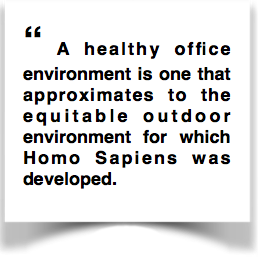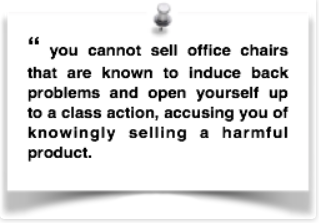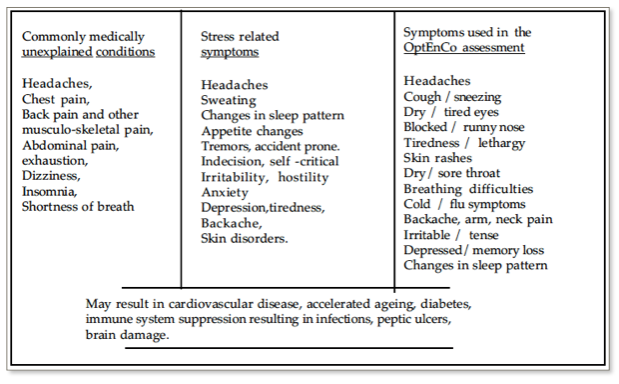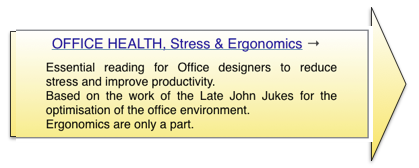Office managers concerned with office health can asses the ergonomic efficiency of any office chair and avoid the choice of a model that is about to become ‘retro’ unless that is the image that their company wishes to project regardless of the well-being of their staff.
Management Perceptions on office health. (2006)
It is a view at the best end of the management spectrum, in the USA, that highly paid, expert workers should have optimum working conditions to provide maximum productivity. Anything less would be economic foolishness. This is hardly the view held by many UK firms which employ a highly paid workforce in an environment which reduces their productivity by a measurable percentage. Office health is vital in the control room environment which operate on a full time basis and where mistakes can lead to a catastrophe. This has been honourably recognised by such firms as Transco, C&W and some police forces which have been careful to optimise the environment in such premises. The offices of companies like Google, Skype and Facebook, are like a playground with innovative furniture which would have looked outrageous ten years ago. The 2T concept introduced in 1998, is now begining to look ordinary although designers still lose out, due to Familiarity bias, with difficulty in recognising the underlying bio-mechanical essentials. An office manager should have an important role here.
On a less upbeat note …
According to HSE Gov, 8.9 million working days were lost due to work-related musculoskeletal disorders in 2016-2017. 507,000 workers suffered a work-related musculoskeletal disorder and 83% of those were back and neck related
- Office staff are likely to include the 70% cohort of the population that are genetically liable to develop LBP if exposed to adverse factors such as upright sitting.
- A proportion will demand a 2T chair for office work and approach their office manager.
- In my experience, most patients with LBP immediately recognise the significance of a 2T
 chair.
chair. - 2T (or 3/4M) chairs may become obligatory for prolonged sedentary use.
- Only a few firms wish to have a ‘retro’ look. Most want to project a cutting edge image. ‘Coolness’ is the word. A 2T chair answers this exactly and in addition reduces LBP and increases productivity by lessened morbidity and stress.
- Once a 2T chair hits the market there will be much media interest providing automatic PR. Firms without a 2T model are likely to be disadvantaged.
Attitudes of office manager to Morbidity
An office manager is often unaware of environmental deficit on office health and so minor morbidity is ignored and regarded as normal. The relationship between the physical office environment, minor morbidity and productivity is not understood. Staff are often unaware of environment problems which can only be assessed by investigation using a system shown below.
Most symptoms abate on quitting the office and others settle with a day or two off work. It is only when a worker is forced to leave the job as a result of a possible work related illness that senior management become aware that a problem exists. The danger of litigation can seriously concentrate the mind.
Litigation
Litigation is regarded as an American disease and it is hoped that it will not spread to here or if it does so it will be in a less virulent form. However it is arriving and the legal and medical climate of litigation is changing. To take Repetitive Strain Injury (RSI) as an example. RSI was described as an epidemic of office workers in Australia and prompted widespread litigation with damages awarded. The medical reaction concluded that most if not all was psychogenically determined and perpetuated by financial rewards. In the UK a judge ruled, that the plaintiffs case should be rejected , on medical evidence, on the grounds that RSI was not a medical condition. Subsequent medical investigation demonstrated specific local lesions in some cases and a less certain generalised pain condition in others. The condition is now renamed Work Related Upper Limb Disorder (WRULD) and providing a local anatomical lesion can be identified is now accepted as a respectable condition by doctors and lawyers. A similar affair occured earlier in Sweden when the government became concerned by an expensive epidemic of LBP among workers. Following an investigation by Professor Alf Nachemson a reduction in the over generous benefit system was recommended and this resulted in the epidemic subsiding rapidly to the normal incidence. Litigation becomes a real possibility when a patient actually has to stop work because of ill health due to working conditions. Hitherto there has been a reluctance to institute proceedings as it has been difficult to prove the relationship between the condition and the workplace. This is changing as research progresses with more awareness of the factors involved. On the other hand most doctors are inclined to discourage litigation as this perpetuates symptoms and can lead to depressive illness. As a doctor working in the field of musculo-skeletal disorders I saw a number of individuals as patients who are highly paid but work in poor environments. The poor ergonomic facilities result in a musculo-skeletal breakdown and in addition they usually had symptoms of stress. As they were well paid and not prepared to litigate, not wishing to confront the  management with their problems, and even trying to keep them secret. Some smaller firms have a macho philosophy which extends to their expert workforce who are proud to grit their teeth and carry on in an adverse environment. The breakdown, when it comes, is complete.
management with their problems, and even trying to keep them secret. Some smaller firms have a macho philosophy which extends to their expert workforce who are proud to grit their teeth and carry on in an adverse environment. The breakdown, when it comes, is complete.
The view in some low tech firms, and in 3rd world work practice, is that optimisation is uneconomic as the rate of worker turn over (churn rate)is too great. It is not recognised that a better environment would reduce the churn rate and increase the productivity of the individual worker, even in a society with low wages and high unemployment. Firms employing third world practices exist in the UK especially in areas where there are illegal immigrants. When condemning this situation it must be remembered that sixpence a day is better than no bread.
The majority of firms fall between these extremes. They are aware that there are problems which can prove to be expensive. Doctors are employed as consultants. There is a considerable body of expertise available in the field of industrial medicine which has helped to reduce accidents and prevelance of industrial disease. However, background environmental factors have only been considered piecemeal and their overall importance is yet to be fully appreciated.
LBP (& 2T) is already of interest to Insurance.
Notes from Canada. (Personal communication) Population of: 34 million. Population of British Columbia: 4.5million From 2000 to 2004 Worksafe [Workers’ Compensation Board] in British Columbia [BC] received over 107,000 claims for back strains accounting for just over 25% of all WorkSafeBC claims. 60% to 90% of the population will experience lower back pain in their lifetime.If a person on registering for insurance does not declare back pain but their medical records do have such a history, then they’ll be refused or subsequently invalidate their insurance. Also, a medically proven device/chair which reduces/eliminates back pain could become an insurance requirement [in north America] where there was a personal history of such problems or a regular occupational hazard. Whereas there is a considerable proportion of back pain/injury attributable to patient handling, all back pain sufferers need to be able to sit comfortably, preferably in a position which aids recovery. The 2Tilt therefore has an universal application in this sector and may be marketed as such. The statistics above illustrate market size and potential. This does not include preventive provision, a further large market of great commercial interest to insurance companies.
A digression
- SLEEP→
- Alternative SITTING ideas→
- Reclined mode advantages↔
- Articles, from Opt-En-Co, giving greater detail of measures for environment optimisation are available. They are old but still relevant.


